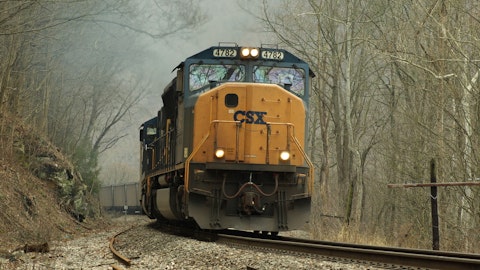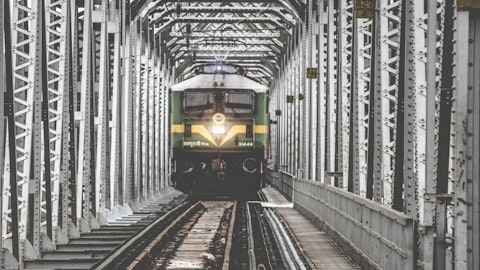Robert Wertheimer: Perfect. Thank you. And then one last one to close out mining really strong, I think, particularly for some of your customers. Any sign that that has peaked out? Are we still early in that cycle? Just any commentary there and then I will stop.
John Olin: So we didn’t — I don’t think we caught the first part of the question.
Robert Wertheimer: Beg pardon. Mining is quite strong, especially I think, for some of your customers. I’m just curious if that strength continue or whether you’re seeing any signs that could plateau?
Rafael Santana: It continues. Mining is very strong right now and all the indications we’ve got is of that momentum continuing into next year as well. So that’s certainly are not one of the positive momentum that we see on the business.
Robert Wertheimer: Thank you.
Operator: The next question is from Steve Barger of KeyBanc Capital Markets. Please go ahead.
Steve Barger: Hey, thanks good morning. Rafael. Backlog has been stable at around $22 billion for the 5 years post the GE deal. Do you think of that as a natural run rate, meaning if things go to plan, it will be around the same 5 years from now? Or the way it’s structured does monetization speed up at some point, meaning revenue accelerates but backlog contracts. How do you think about that long-term?
Rafael Santana: Rob, I’m not going to give you like specific numbers you’re thinking 5 years from now. I just think — I’ll tell you how we’re running the business, right? There is really a strong focus on making sure that we’ve got the coverage as we look ahead, and that coverage supports what I’ll call profitable growth for the business. That’s where a big piece of focus has been. In the past, if you go back, there’s maybe a lot of focus, especially on multiservice agreements that covered fleets for a long period of time. We’ve managed that in mix with long-term parts agreements. In some cases, we might take a different approach depending on what the fleets are with the customers. So all in all, I think those are levers that we got to be managing and really thinking more about the value that we’re delivering, especially as we introduce more opportunities to improve fleets.
A lot of the upgrades that we talk about in terms of fuel efficiency and things like that. We want to make sure we’re driving value for both our customers and ourselves through that process. But all in all, I mean, we expect to continue to drive that momentum forward with profitable growth. Does that help?
Steve Barger: Yes, I think so. If I can just boil that down, it sounds like you do expect when you look at your pipeline and how you try to manage the business that you’ll have 2x the forward years revenue in backlog for the foreseeable future? Is that fair?
John Olin: I don’t think we can — we would put an index on it. Just looking at the backlog over the last 5 years, we’ve seen it oscillate between 21.5 and 22.5 I think parts of it are the economy that goes into that. And when we have periods of big orders, we see it rise and then that kind of burns off. And that’s exactly what we’re seeing in 2022 to 2023, right? We saw it rise about $1 billion in 2022. And as we work that off, we’re lapping those numbers and backlogs down 4% or 5%. So I think over a long period of time, we would expect it to rise, but I don’t think there’s a formula you can put on it. We keep coming back to this word lumpy, is that — it is very lumpy depending on what multi-years. I think the best way to remove the lumpiness is to look at the 12 months, right? So we don’t — we kind of neutralize for that, and the 12 month has been very steady and growing up on the three quarters this year and has been gaining momentum.
Rafael Santana: This is a business that go before the transactional was done. There was a lot of, I’ll call, ups and downs through the cycle. I think one of the things that the team has been very purposeful on is making sure we are working with customers to drive what I’ll call sustainable investments moving forward, which plays well for the entire ecosystem. It’s an element of making sure that we’re ultimately getting to the right quality, the right value for the products ultimately to better costs as we run some of these programs. And that’s been a huge part of the focus. If you think about the focus on 12-month backlog 18, 24, that’s a significant part of it. And the longer-term agreements will play them to make sure that we’ve got the continuation of a lot of the infrastructure that we’ve got out there that supports the delivery of some of these assets for customers around the world.
Steve Barger: Yes. That’s good color. And the only comment I’ll make is mid-single-digit percentage variance around a $21 billion 5-year average is not that lumpy. I think a lot of companies would love to have that. As my follow-up, John, I know you don’t want to get into specific line items around the strike, but this was a record quarter for Freight revenue and the best segment margin since 2019. Can you tell us what revenue and margin could have been? And is it fair to say this quarter will not be a high watermark as we think about Freight in 2024?
John Olin: Well, we expect to continue to grow this company in 2024, 2025 and 2026, Steve, and well beyond that. No, I can’t pull out what it would look like without. All I can say is it was a tremendous effort on the part of the overall company to be able to deliver that revenue growth and again, I talked about the locomotive piece, right, and that shift. We delivered all the locomotives in the second quarter that we were intending to deliver with the 10-week strike at our largest plant that makes locomotives. So it’s a tremendous tribute to the team and how the whole company pulled together to continue to work through the strike.
Steve Barger: Got it. Thank you.
John Olin: Thank you.
Operator: This concludes our question-and-answer session. I would like to turn the conference back over to Kristine Kubacki for closing remarks.
Kristine Kubacki: Thank you, Kate. And thank you, everyone, for your participation today. We look forward to speaking with you again next quarter.
Operator: The conference has now concluded. Thank you for attending today’s presentation. You may now disconnect.
Follow Westinghouse Air Brake Technologies Corp (NYSE:WAB)
Follow Westinghouse Air Brake Technologies Corp (NYSE:WAB)
Receive real-time insider trading and news alerts



